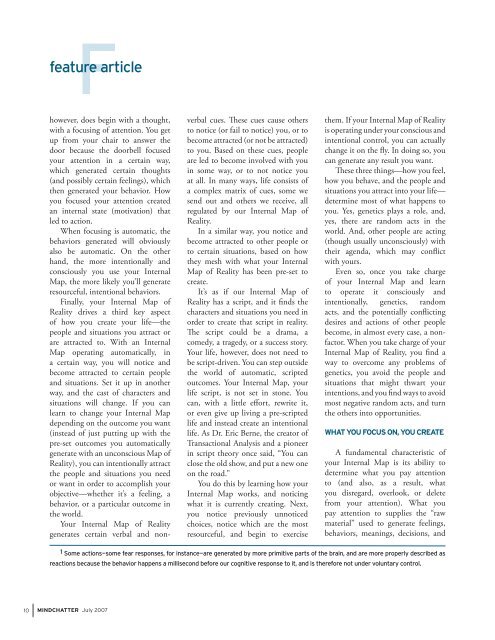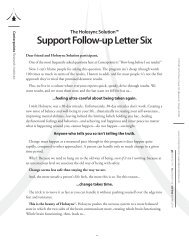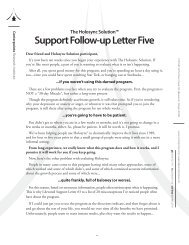Mind Chatter #174 (July, 2007) (PDF) - Centerpoint Research Institute
Mind Chatter #174 (July, 2007) (PDF) - Centerpoint Research Institute
Mind Chatter #174 (July, 2007) (PDF) - Centerpoint Research Institute
You also want an ePaper? Increase the reach of your titles
YUMPU automatically turns print PDFs into web optimized ePapers that Google loves.
feature articlehowever, does begin with a thought,with a focusing of attention. You getup from your chair to answer thedoor because the doorbell focusedyour attention in a certain way,which generated certain thoughts(and possibly certain feelings), whichthen generated your behavior. Howyou focused your attention createdan internal state (motivation) thatled to action.When focusing is automatic, thebehaviors generated will obviouslyalso be automatic. On the otherhand, the more intentionally andconsciously you use your InternalMap, the more likely you’ll generateresourceful, intentional behaviors.Finally, your Internal Map ofReality drives a third key aspectof how you create your life—thepeople and situations you attract orare attracted to. With an InternalMap operating automatically, ina certain way, you will notice andbecome attracted to certain peopleand situations. Set it up in anotherway, and the cast of characters andsituations will change. If you canlearn to change your Internal Mapdepending on the outcome you want(instead of just putting up with thepre-set outcomes you automaticallygenerate with an unconscious Map ofReality), you can intentionally attractthe people and situations you needor want in order to accomplish yourobjective—whether it’s a feeling, abehavior, or a particular outcome inthe world.Your Internal Map of Realitygenerates certain verbal and nonverbalcues. These cues cause othersto notice (or fail to notice) you, or tobecome attracted (or not be attracted)to you. Based on these cues, peopleare led to become involved with youin some way, or to not notice youat all. In many ways, life consists ofa complex matrix of cues, some wesend out and others we receive, allregulated by our Internal Map ofReality.In a similar way, you notice andbecome attracted to other people orto certain situations, based on howthey mesh with what your InternalMap of Reality has been pre-set tocreate.It’s as if our Internal Map ofReality has a script, and it finds thecharacters and situations you need inorder to create that script in reality.The script could be a drama, acomedy, a tragedy, or a success story.Your life, however, does not need tobe script-driven. You can step outsidethe world of automatic, scriptedoutcomes. Your Internal Map, yourlife script, is not set in stone. Youcan, with a little effort, rewrite it,or even give up living a pre-scriptedlife and instead create an intentionallife. As Dr. Eric Berne, the creator ofTransactional Analysis and a pioneerin script theory once said, “You canclose the old show, and put a new oneon the road.”You do this by learning how yourInternal Map works, and noticingwhat it is currently creating. Next,you notice previously unnoticedchoices, notice which are the mostresourceful, and begin to exercisethem. If your Internal Map of Realityis operating under your conscious andintentional control, you can actuallychange it on the fly. In doing so, youcan generate any result you want.These three things—how you feel,how you behave, and the people andsituations you attract into your life—determine most of what happens toyou. Yes, genetics plays a role, and,yes, there are random acts in theworld. And, other people are acting(though usually unconsciously) withtheir agenda, which may conflictwith yours.Even so, once you take chargeof your Internal Map and learnto operate it consciously andintentionally, genetics, randomacts, and the potentially conflictingdesires and actions of other peoplebecome, in almost every case, a nonfactor.When you take charge of yourInternal Map of Reality, you find away to overcome any problems ofgenetics, you avoid the people andsituations that might thwart yourintentions, and you find ways to avoidmost negative random acts, and turnthe others into opportunities.WHAT YOU FOCUS ON, YOU CREATEA fundamental characteristic ofyour Internal Map is its ability todetermine what you pay attentionto (and also, as a result, whatyou disregard, overlook, or deletefrom your attention). What youpay attention to supplies the “rawmaterial” used to generate feelings,behaviors, meanings, decisions, and1 Some actions—some fear responses, for instance—are generated by more primitive parts of the brain, and are more properly described asreactions because the behavior happens a millisecond before our cognitive response to it, and is therefore not under voluntary control.10 MINDCHATTER <strong>July</strong> <strong>2007</strong>
















